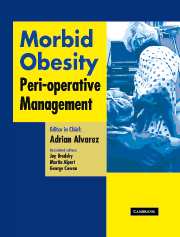Book contents
- Frontmatter
- Contents
- Contributors
- Foreword
- Preface
- Acknowledgments
- Dedication
- Section 1 General aspects
- Section 2 Pathophysiology
- 4 Lung physiology
- 5 Cardiac morphology and ventricular function
- 6 Pathophysiology of cardiovascular co-morbidities
- 7 Physiological changes during laparoscopy
- 8 Digestive physiology and gastric aspiration
- Section 3 Pre-operative management
- Section 4 Peri-operative management of co-morbidities
- Section 5 Pharmacology
- Section 6 Monitoring
- Section 7 Intra-operative management
- Section 8 Post-operative care
- Section 9 Conclusions
- Afterword
- Index
8 - Digestive physiology and gastric aspiration
from Section 2 - Pathophysiology
Published online by Cambridge University Press: 17 August 2009
- Frontmatter
- Contents
- Contributors
- Foreword
- Preface
- Acknowledgments
- Dedication
- Section 1 General aspects
- Section 2 Pathophysiology
- 4 Lung physiology
- 5 Cardiac morphology and ventricular function
- 6 Pathophysiology of cardiovascular co-morbidities
- 7 Physiological changes during laparoscopy
- 8 Digestive physiology and gastric aspiration
- Section 3 Pre-operative management
- Section 4 Peri-operative management of co-morbidities
- Section 5 Pharmacology
- Section 6 Monitoring
- Section 7 Intra-operative management
- Section 8 Post-operative care
- Section 9 Conclusions
- Afterword
- Index
Summary
Physiology of gastric acid production
Introduction
The stomach secretes hydrochloric acid, intrinsic factor, bicarbonate, and mucus into its lumen. Functionally the stomach is divided into two parts: proximal and distal. The proximal part comprises the anatomic corpus and fundus. The distal portion is the antrum or pyloric gland region.
The cells responsible for gastric secretions are mucosal cells that line the surface of the gastric wall. The major secretory cells in the proximal part of stomach are parietal (oxyntic) cells, which secrete acid and intrinsic factor, and the chief (or peptic) cells, which secrete group I pepsinogen. In the distal portion of the stomach, pyloric glands secrete the hormones gastrin and somatostatin. Throughout the stomach, mucus neck cells secrete mucus and group II pepsinogen, and surface epithelial cells secrete bicarbonate, mucus, and group II pepsinogen.
Gastric acid secretion varies according to the time of the day, the time and types of food intake, psychological states, and other metabolic activities of the body. The cephalic phase of gastric secretion regulation is activated by thoughts of food, by sight, smell, and taste of food, and by the acts of chewing and swallowing. The vagus nerve is the major stimulatory pathway via M1 muscarinic cholinergic receptors.
- Type
- Chapter
- Information
- Morbid ObesityPeri-Operative Management, pp. 89 - 110Publisher: Cambridge University PressPrint publication year: 2004



